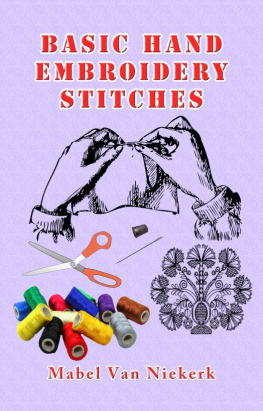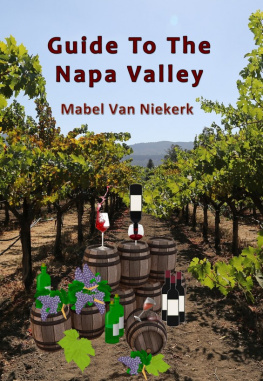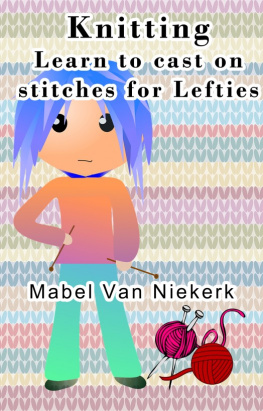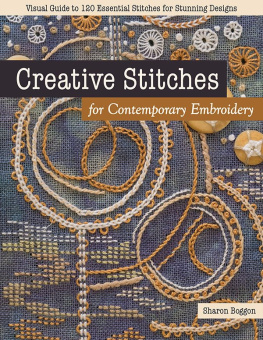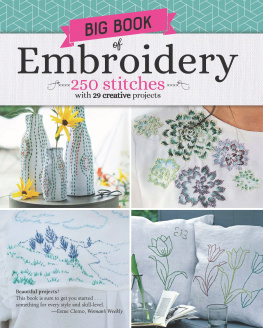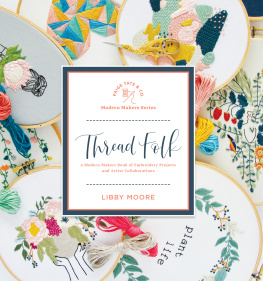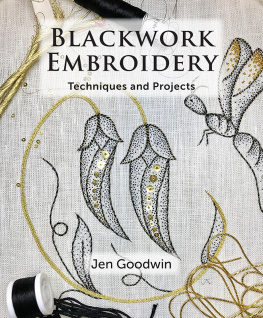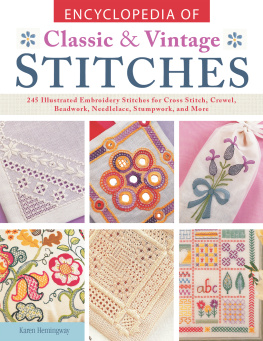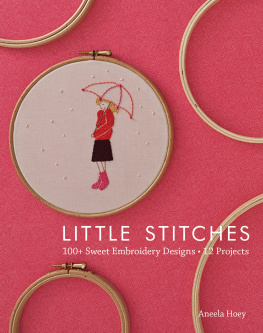Basic Hand EmbroideryStitches
By
Mabel VanNiekerk
SMASHWORDS EDITION
*******
Publishedby
Mabel Van Niekerk at Smashwords
Basic HandEmbroidery Stitches
Copyright 2013 Mabel Van Niekerk
SmashwordsEdition, License Notes
This ebook is licensedfor your personal enjoyment only. This ebook may not be re-sold orgiven away to other people. If you would like to share this bookwith another person, please purchase an additional copy for eachrecipient. If youre reading this book and did not purchase it, orit was not purchased for your use only, then please return toSmashwords.com and purchase your own copy. Thank you for respectingthe hard work of this author.
Content
Basic Hand Embroidery Stitches
Embroidery isan art that almost every nation on earth embraced at sometimeduring their early history. History even records people who livedthousands of years BC, who stitched designs on their animal skingarments.
Embroidery wasalways a lavish form of embellishment on clothing, and later on,household articles. We can even read in the Bible about thebeautiful embroidery that was done on the curtains of Solomonstemple. Women were hand selected who were talented in this craft todo this honorable work. They embroidered exquisite designs in puregold threads, and I think one could say that they were creatingworks of art with their needles and thread.
Hundreds ofyears ago young girls were not educated in reading and writing, butwere taught the rudiments of embroidery. They would receiveinstruction in this craft from a young age. Many examples ofembroidery work can be seen to this day in ancient palaces andcastles in Europe and makes one realize what painting by needlereally means.
As happenswith all crafts, with time they go through various stages of changeand development. Today this beautiful craft is still practiced,even though there are many sophisticated machines on the globe thatcan do exquisite embroidery work, in a fraction of the time thatone could do it by hand. Stitching on a unique design is verytherapeutic. Avid embroiderers love to display their work byframing it to adorn the walls of their homes or turning them intoeye-catching cushions, table and bedroom linen. Embroidery is neverout of fashion to decorate clothing, purses and even shoes.
I have lovedthis craft since I learnt it at my mothers knee when I was alittle girl. Later on I was privileged to learn more from a masterembroiderer who had studied in an ancient college of embroidery andlace making in Europe.
In actual factits very simple to learn to embroider. There are various types ofstitches used to create a work of art which are really easy tomaster. This is a craft that should never be done in a hurry.
Today thereare so many types of threads, silks, yarns and wools available incraft stores that can be used on any weight fabric and for anygarment or item. You can spend many happy hours browsing in craftstores taking note of what is available for embroiderers. Designsfor embroidery work are always available as well, but there isnothing like stitching your very own design.
Basicrequirements for embroidery
Carbon paper is helpful totransfer designs onto the fabric.
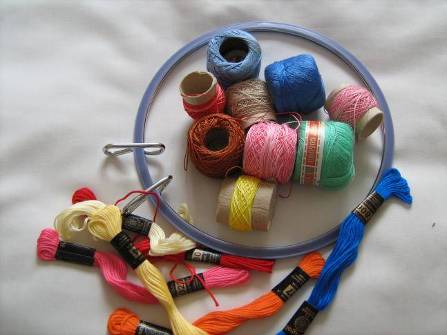
Frames andhoops
You will need a frame orhoop on which to keep your fabric taut while embroidering. The typeand size of the hoop or frame will depend on the size of theproject. A small hoop is adequate for a small piece of fabric, ifhowever you intend embroidering a picture you wish to frame, thenthe embroidery frame has to fit the size of the design.
An embroideryhoop consists of two hoops an outer hoop and an inner hoop. Thefabric is placed over the inner hoop and then the outer hoop isplaced over the fabric.
These hoopscan be made from wood or plastic. If the outer hoop is made ofplastic it will usually have a stainless steel wire inner hoop,which is open on the one side with two small levers on either sideof the opening. Hold the two levers together and then place overthe fabric. By releasing the levers the hoop will fit snugly overthe fabric and keep it taut while you are embroidering. These hoopsare known as spring tension hoops and are probably the best to usefor small projects.
Some hoopshave an adjustable screw on the one side so that you can tighten itto hold the fabric as taut as you want it to be.
Large frames,which are often referred to as tapestry frames come in varioussizes. They are made from wood and come in various models.Adjustable lap and table stands are available, which makes itconvenient to work with both hands from the top and the bottom ofthe fabric, whether you place the stand on your lap or on thetable. The height of the stand is adjustable.
Frames arealso available with a rotating split rail scroll on either side ofthe frame, on which fabric can be rolled that is not in use. As youcomplete embroidering the section visible on the frame you unroll apiece of fabric from the rail scroll and the section that has beencompleted can be rolled up on the other side. This means that youalways have a section of fabric in front of you that is taut towork on.
Stands thatallow the frame to swivel without difficulty, if you need to keepturning the frame to work from different angles, are very nice towork on. There are many stands and frames to choose from, so firstdecide how often you are going to use one before spending a fortuneon a deluxe model.
Frame standswith a magnifying glass and light attached make it easier to seeyour work.
Fabrics used forembroidery
Thereis no limit to which type of fabrics should be used for embroiderywork. Some fabrics are just easier to work on than others.
Specificfabrics for embroidery are cotton, linen and various blends ofcotton and rayon.
There arespecific fabrics woven for cross stitch, which makes it easy tocount the rows of threads horizontally and vertically. Aida is oneof these fabrics that is woven in distinguishable squares to makeit easy to do counted cross stitch designs.
The looserwoven fabrics are ideal for techniques like drawn thread, countedthread and pulled thread. Aida is also excellent for thispurpose.
The tightlywoven fabrics are good for general embroidery stitches.
Once you havebecome accomplished with all the embroidery stitches, then it willbe time enough to try out working on silks and other more delicatefabrics.
Needles
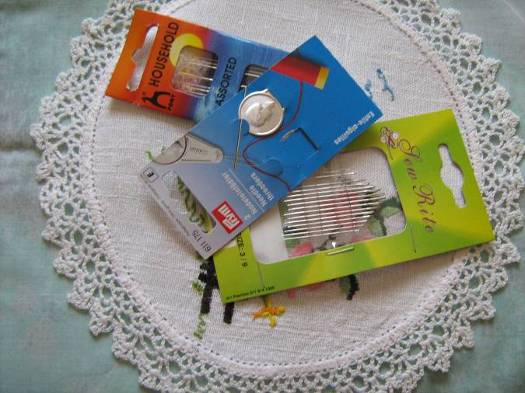
Check yourneedlework and craft store for needles made specifically forembroidery work. You need a thin sharp needle with a large eye, asmost often you will be sewing with stranded cotton.
The size ofthe needles will also depend on what type of embroidery you intenddoing. Embroidery needles range from size 0 to 10.
Thread
There are various types of threadintended for embroidery and many brand-names around, but there aredefinitely some that are nicer to work with than others. The bestway to choose the threads you would like to work with is to browsearound your craft store and see what they have on offer. Askquestions if you are not sure what is best to use to start yourfirst project.
Color is ahuge factor in embroidery threads each brand has a wonderful arrayof colors. Mix and match is the easiest thing to do to make yourproject something really special.
The bestthread to work with is silk thread, but these threads can becomeexpensive so are often only used on special projects.

